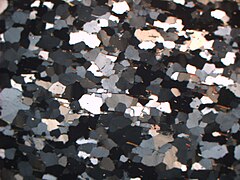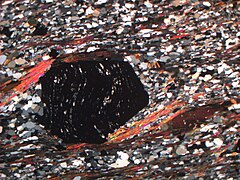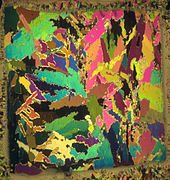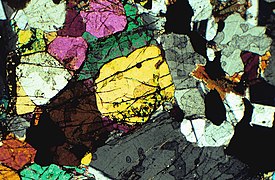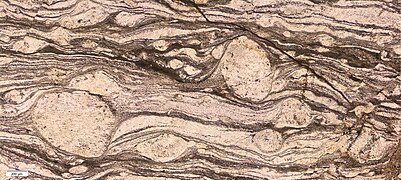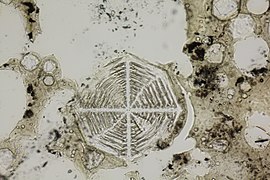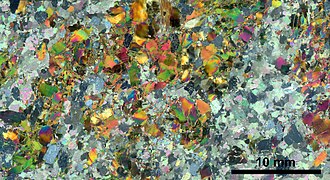Thin section

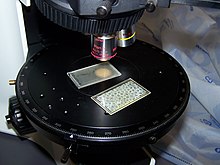

Inoptical mineralogyandpetrography,athin section(orpetrographic thin section) is a thin slice of arockormineralsample, prepared in a laboratory, for use with apolarizingpetrographic microscope,electron microscopeandelectron microprobe.A thin sliver of rock is cut from the sample with adiamond sawand ground optically flat. It is then mounted on a glassslideand then ground smooth using progressively finer abrasive grit until the sample is only 30μmthick. The method uses theMichel-Lévy interference colour chartto determine thickness, typically usingquartzas the thickness gauge because it is one of the most abundant minerals.
When placed between two polarizing filters set at right angles to each other, the optical properties of the minerals in the thin section alter the colour and intensity of the light as seen by the viewer. As different minerals have different optical properties, most rock forming minerals can be easily identified.Plagioclasefor example can be seen in the photo on the right as a clear mineral with multiple paralleltwinningplanes. The large blue-green minerals areclinopyroxenewith some exsolution oforthopyroxene.
Thin sections are prepared in order to investigate the optical properties of the minerals in the rock. This work is a part ofpetrologyand helps to reveal the origin and evolution of the parent rock.
A photograph of a rock in thin section is often referred to as aphotomicrograph.
Thin sections are also used in the microscopic study of bones, metals and ceramics.
Quartz in thin section[edit]

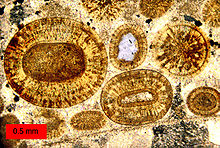
Description[edit]
In thin section, when viewed inplane polarized light(PPL),quartzis colorless with low relief and no cleavage. Its habit is either fairly equant or anhedral if it infills around other minerals as a cement. Undercross polarized light(XPL) quartz displays low interference colors and is usually the defining mineral used to determine if the thin section is at standardized thickness of 30 microns as quartz will only display up to a very pale yellow interference color and no further at that thickness, and it is very common in most rocks so it will likely be available to judge the thickness.[1]
Determining provenance[edit]
In thin section, quartz grainprovenancein a sedimentary rock can be estimated. In crossed polarized light, the quartz grain can go extinct all at once, called monocrystalline quartz, or in waves, called polycrystalline quartz. The extinction in waves is calledundulose extinctionand indicates dislocation walls in mineral grains. Dislocation walls are where dislocations, intracrystalline deformation via movement of a dislocation front within a plane, organize themselves into planes of sufficient quantity. They change the crystallographic orientation across the walls, so for example in quartz, the two sides of the wall will have slightly differentextinction anglesand thus result in undulose extinction.[2]Since undulose extinction requiresdislocation wallsto have developed, and these occur more easily at higher pressures and temperatures, quartz grains with undulose extinction indicatemetamorphic rockprovenance for that grain. Those grains that are monocrystalline quartz are more likely to have been formed byigneousprocesses. Differing sources suggest the extent to which this proxy for provenance can be used. Some note the trend for immaturesandstonesto have less polycrystalline quartz grains compared to mature sandstones, which have grains that have passed through many sedimentary cycles.[3]Quartz grains derived from previous sedimentary sources are determined by looking forauthigenic,or grown in place, overgrowths of silica cement over the grain.[4]
Other distinguishing features[edit]
The above descriptions of quartz in thin section are usually enough to identify it. Minerals with similar appearance may includeplagioclase,although it can be distinguished by the distinctivetwinningin crossed-polarized light and cleavage in plane-polarized light, andcordierite,although it can be distinguished by twinning or inclusions in the grain. However, for certainty, other distinguishing features of quartz include the fact that it isuniaxial,it has a positiveoptic sign,length-slow sign of elongation, and zero degree extinction angle.[5]

Ultra-thin sections[edit]
Fine-grained rocks, particularly those containing minerals of highbirefringence,such ascalcite,are sometimes prepared as ultra-thin sections. An ordinary 30μmthin section is prepared as described above but the slice of rock is attached to the glass slide using a soluble cement such asCanada balsam(soluble inethanol) to allow both sides to be worked on. The section is then polished on both sides using a finediamondpaste until it has a thickness in the range of 2–12μm.This technique has been used to study themicrostructureof fine-grained carbonates such as the Lochseitenkalkmylonitein which the matrix grains are less than 5μmin size.[6]This method is also sometimes used in the preparation of mineral and rock specimens fortransmission electron microscopyand allows greater accuracy in comparing features using both optical and electron imaging.[7]
Gallery[edit]
See also[edit]
- Ceramography:thin sections of ceramics
References[edit]
- ^"Rock Thin Sections (Petrographic Thin Section Preparation)".Kemet.Retrieved2018-05-15.
- ^Fossen, Haakon (2016-03-03).Structural geology(Second ed.). Cambridge, United Kingdom: Cambridge University Press.ISBN9781107057647.OCLC946008550.
- ^Blatt, H.; Christie, J.M. (1963). "Undulatory Extinction in Quartz of Igneous and Metamorphic Rocks and Its Significance in Provenance Studies of Sedimentary Rocks".AAPG Datapages.
- ^R., Prothero, Donald (2004).Sedimentary geology: an introduction to sedimentary rocks and stratigraphy.Schwab, F. L. (Frederic L.) (2nd ed.). New York: W.H. Freeman.ISBN0716739054.OCLC52127337.
{{cite book}}:CS1 maint: multiple names: authors list (link) - ^"quartz".www.mtholyoke.edu.Retrieved2018-05-15.
- ^Badertscher, N.P. & Burkhard, M. 2000. Brittle±ductile deformation in the Glarus thrust Lochseiten (LK) calc-mylonite, Terra Nova, 12, 281-288
- ^Barber, D.J. 1981. Demountable polished extra-thin sections and their use in transmission electron microscopy. Mineralogical magazine,44, 357-359
- Shelley, D.Optical Mineralogy, Second Edition.University of Canterbury, New Zealand.
External links[edit]
- Thin sections of soils. Collection of Prof. KubiënaArchived22 September 2020 at theWayback Machine
- Uncommon igneous, metamorphic and metasomatic rocks in thin section, in unpolarized light and under crossed polarizers
- Namethatmineral.com: dynamic data-tables for identification of thin sections under the microscope

